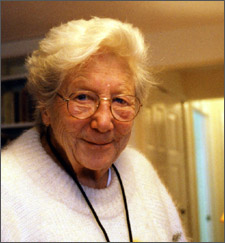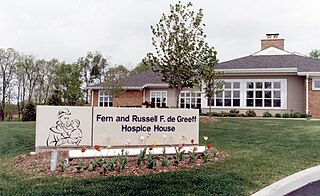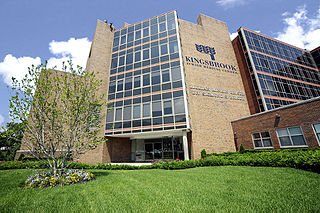
Assisted suicide describes the process by which a person, with the help of others, takes drugs to end their life. It has been referred to as physician-assisted suicide (PAS), assisted suicide, assisted dying or medical aid in dying.
Palliative care is an interdisciplinary medical caregiving approach aimed at optimizing quality of life and mitigating suffering among people with serious, complex, and often terminal illnesses. Within the published literature, many definitions of palliative care exist. The World Health Organization (WHO) describes palliative care as
"an approach that improves the quality of life of patients and their families facing the problem associated with life-threatening illness, through the prevention and relief of suffering by means of early identification and impeccable assessment and treatment of pain and other problems, physical, psychosocial, and spiritual".
In medicine, specifically in end-of-life care, palliative sedation is the palliative practice of relieving distress in a terminally ill person in the last hours or days of a dying person's life, usually by means of a continuous intravenous or subcutaneous infusion of a sedative drug, or by means of a specialized catheter designed to provide comfortable and discreet administration of ongoing medications via the rectal route.
Terminal illness or end-stage disease is a disease that cannot be cured or adequately treated and is expected to result in the death of the patient. This term is more commonly used for progressive diseases such as cancer, dementia, advanced heart disease, and for HIV/AIDS, or long COVID in bad cases, rather than for injury. In popular use, it indicates a disease that will progress until death with near absolute certainty, regardless of treatment. A patient who has such an illness may be referred to as a terminal patient, terminally ill or simply as being terminal. There is no standardized life expectancy for a patient to be considered terminal, although it is generally months or less. An illness which is lifelong but not fatal is called a chronic condition.
Futile medical care is the continued provision of medical care or treatment to a patient when there is no reasonable hope of a cure or benefit.

The New York Cancer Hospital (NYCH) on the Upper West Side of Manhattan, New York City was a cancer treatment and research institution founded in 1884. The building was located at 455 Central Park West between West 105th and 106th Streets, and built between 1884 and 1886 with additions made between 1889 and 1890; it was designed by Charles Coolidge Haight in the Late Gothic and French Chateau styles – inspired by the chateaux of the Loire Valley. It was the first hospital in the United States dedicated specifically for the treatment of cancer, and the second in the world after the London Cancer Hospital. After outgrowing the original building and moving, it became what is today known as Memorial Sloan-Kettering Cancer Center.

The Dominican Sisters of Hawthorne are a Roman Catholic congregation of religious sisters, who are a part of the Third Order of Saint Dominic. The Congregation was founded on December 8, 1900, by Rose Hawthorne Lathrop, a daughter of the famed novelist Nathaniel Hawthorne. They specialize in caring for those suffering from terminal cancer and have no financial resources.

The Sloane Hospital for Women is the obstetrics and gynecology service within NewYork-Presbyterian Hospital and the Department of Obstetrics and Gynecology of the Columbia University College of Physicians and Surgeons (P&S) in New York City. It was founded in 1886 with Columbia P&S as a training and treatment center for obstetrics. It has provided over 100 years of obstetrical care. The hospital is located within Morgan Stanley Children's Hospital.

Florence Wald was an American nurse, former Dean of Yale School of Nursing, and largely credited as "the mother of the American hospice movement". She led the founding of Connecticut Hospice, the first hospice program in the United States. Late in life, Wald became interested in the provision of hospice care within prisons. In 1998, Wald was inducted into the National Women's Hall of Fame.

A hospital is a healthcare institution providing patient treatment with specialized health science and auxiliary healthcare staff and medical equipment. The best-known type of hospital is the general hospital, which typically has an emergency department to treat urgent health problems ranging from fire and accident victims to a sudden illness. A district hospital typically is the major health care facility in its region, with many beds for intensive care and additional beds for patients who need long-term care.

In the United States, hospice care is a type and philosophy of end-of-life care which focuses on the palliation of a terminally ill patient's symptoms. These symptoms can be physical, emotional, spiritual, or social in nature. The concept of hospice as a place to treat the incurably ill has been evolving since the 11th century. Hospice care was introduced to the United States in the 1970s in response to the work of Cicely Saunders in the United Kingdom. This part of health care has expanded as people face a variety of issues with terminal illness. In the United States, it is distinguished by extensive use of volunteers and a greater emphasis on the patient's psychological needs in coming to terms with dying.

Hospice care is a type of health care that focuses on the palliation of a terminally ill patient's pain and symptoms and attending to their emotional and spiritual needs at the end of life. Hospice care prioritizes comfort and quality of life by reducing pain and suffering. Hospice care provides an alternative to therapies focused on life-prolonging measures that may be arduous, likely to cause more symptoms, or are not aligned with a person's goals.
Euthanasia became legal in New Zealand when the End of Life Choice Act 2019 took full effect on 7 November 2021. It is illegal to "aid and abet suicide" under Section 179 of the New Zealand Crimes Act 1961. The clauses of this act make it an offence to "incite, procure or counsel" and "aid and abet" someone else to commit suicide, regardless of whether a suicide attempt is made or not. Section 179 covers both coercion to undertake assisted suicide and true suicide, such as that caused by bullying. This will not change under the End of Life Choices Act 2019, which has provisions on coercion of terminally ill people.

In the United States, the term "assisted suicide" is typically used to describe what proponents refer to as "medical aid in dying", in which a terminally ill adult is prescribed, and self-administers, barbiturates if they feel that they are suffering significantly. The term is often used interchangeably with "physician-assisted suicide" (PAS), "physician-assisted dying", "physician-assisted death", "assisted death", and "medical aid in dying" (MAiD).
Gloria Taylor was a Canadian who was an advocate of medically-assisted dying and suffered from Amyotrophic lateral sclerosis (ALS), also known as Lou Gehrig's disease. Taylor began to experience the early symptoms of ALS in 2003. A neurologist diagnosed her disease in 2009.

Kingsbrook Jewish Medical Center was a 303-bed full-service community teaching hospital with an estimated 2,100 full-time employees, located in the neighborhood of East Flatbush in Brooklyn, New York. The hospital was made up of a complex of eight conjoined buildings which are dispersed over a 366,000 square foot city block.

Ernest Frederic Neve (1861-1946) was a British surgeon, Christian medical missionary, and author who provided medical care to the people of Kashmir and pioneered work on Kangri cancer. He established the Kashmir Mission Hospital and the Kashmir State Leper Hospital with his brother Arthur Neve and made significant contributions to the healthcare facilities in Kashmir throughout the over 50 years that he spent there.

Hospice Egypt is a Josaab foundation project aims to provide palliative care and end-of-life care services to terminally ill patients aged 18 years and above through governorates of Egypt.

National Homeopathic Hospital is a defunct American hospital. Located in Washington, D.C., it was established in 1881, and became Hahnemann Hospital in 1956.

Montefiore Home for Chronic Invalids was an American sanatorium charity hospital. Founded in 1884 in Manhattan, New York at Avenue A and 84th Street, the sanatorium relocated to a larger building in Manhattan on 138th Street before removing to The Bronx in 1910. It also changed names several times.














